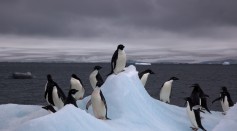nature
The Secret To a Chameleon’s Color Change—It’s Crystals
Catalina Fox Populations—From the Brink of Extinction to Potentially Off the List
Myanmar Bird Fools Scientists Who Thought That It Was Extinct

SeaWorld Researchers Change the Conversation—Saving Stranded Sea Lion Pups
Scientists Have Finally Determined the Weight of Famed Stegosaurus
Climate Change Helped Fuel Syrian Civil War
Ancient Human Jaw Bone Evidence of Earlier Evolution
Arctic Ice Thinning Much Faster Than Scientists Thought
“Alien of the Deep” Makes Its Way to the Australian Museum
Genes Show Where Penguins Called Home During the Ice Age
‘Skeletorus’ and ‘Sparklemuffin’ Species Discovered—Seriously Colorful Spiders
How the Oceans Could Be Our Salvation from Global Warming
Leave it to the Limpets—Researchers Find New Strongest Natural Material On Earth

Life in The Cold—How Penguins Deal Without Sweet & Savory Sensations
Most Popular

AI Revolution in Medical Education: Transforming How Healthcare Professionals Learn

Optimizing Complex Catalog Systems with Graph Theory and Indexing

Exploring Life Beyond Earth: Study Claims Other Planets Could Be Suitable for Alien Life

Nikolay Karpenko Biography, Photo, Career, Accomplishments





